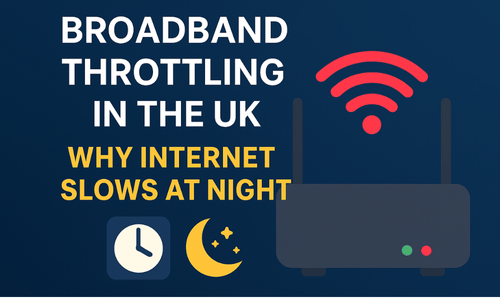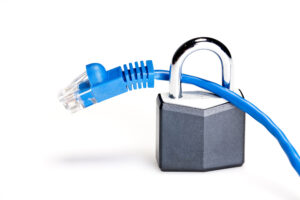The Truth About Broadband Throttling in the UK: What Providers Don’t Tell You

Why Is My Internet So Slow at Night?
You finally sit down after a long day, ready to stream your favourite show, jump into a gaming session, or join a late-night video call. But suddenly… the buffering begins. Pages crawl, videos freeze, and downloads drag on for ages. Sound familiar?
If you’ve ever wondered why your broadband slows down exactly when you need it most, you’re not alone. And the answer isn’t always “bad Wi-Fi” or “too many devices.”
Often, what you’re experiencing is something many UK broadband providers would rather not talk about: broadband throttling.
At Broadband Freedom, we believe in full transparency. So in this guide, we’re pulling back the curtain on throttling:
- What it really is
- Why it happens (even if your plan says “unlimited”)
- Which providers are the biggest culprits
- And most importantly, how you can protect yourself
We’ve seen too many users locked into contracts with hidden limits and vague “fair usage policies.” That’s why we built resources like our Compare Broadband Providers page; to help you find deals that won’t cut corners on your connection.
Whether you’re tired of lagging Zoom calls or late-night Netflix disasters, we’re here to help you take control of your internet experience. And by the time you finish reading this guide, you’ll know exactly how to spot, stop, and avoid broadband throttling in the UK.
Let’s dive in.
What Is Broadband Throttling — And Is It Legal in the UK?
Broadband throttling sounds technical, but here’s the plain truth:
It’s when your internet provider deliberately slows down your connection.
Yes — on purpose.
This usually happens when:
- You’re using too much data during peak hours
- You’re streaming, gaming, or torrenting on a “fair usage” plan
- You hit an invisible cap that isn’t clearly stated in the contract
It’s frustrating. You’re paying for fast, “unlimited” broadband — but your provider is silently putting the brakes on your speed behind the scenes.
Why Do Providers Throttle Broadband?
Providers usually blame “network congestion” or “fair usage.” What they often don’t say outright is this:
They’re prioritising other users by slowing down your connection.
Most throttling happens during peak hours (6 PM – 11 PM) — right when families are streaming TV, gamers are online, and work-from-home users are uploading files.
You’ll especially feel it if you live in a densely populated area or share your connection with multiple users.
If this sounds familiar, you’re not imagining it. This is throttling — and it’s more common than most providers admit.
Is Throttling Legal in the UK?
Yes — but only under certain conditions.
Under Ofcom regulations, ISPs must clearly state any traffic management or speed restrictions in their contract. The issue is, most bury this info in their “Acceptable Use Policy” or “Fair Usage Terms” — not in the sales pitch.
Providers like Virgin Media and BT have had reports of slowing connections at peak times, even when advertising “ultrafast” packages.
You can learn more about recent provider behaviour in our breakdown of the Virgin Media 2025 Price Hike.
How to Tell If You’re Being Throttled (Without Guessing)
Most broadband users never realise they’re being throttled — because providers don’t tell you when it’s happening.
But at Broadband Freedom, we believe you deserve to know. So here’s how to find out for yourself, step-by-step.
Step 1: Run Speed Tests — The Smart Way
Running a random speed test once a day isn’t enough. Throttling is often time-based, so you’ll need to test at different times of day:
- Morning (8–10 AM)
- Afternoon (1–3 PM)
- Evening (7–10 PM)
Compare results. If your speed consistently drops in the evening — especially for downloads and ping — that’s a clear sign of throttling.
Try our speed test tool or the following ones:
- Speedtest by Ookla
- Fast.com (run by Netflix)
- ThinkBroadband Quality Monitor
We also break this down in our Broadband Speed UK 2025 article — perfect if you want to understand what speed you should realistically be getting.
Step 2: Compare Your Speed to What You’re Paying For
Grab your contract or plan details. Are you paying for 100 Mbps? 200 Mbps?
If your evening tests regularly show less than half of that (with good Wi-Fi), throttling could be at play.
If you’re not sure how your current provider stacks up, check our Compare Broadband Providers tool — we break down speed claims vs. reality for major UK ISPs.
Step 3: Use a VPN to Test for Throttling
Some providers only throttle specific types of traffic — like streaming, gaming, or torrenting. A VPN (Virtual Private Network) encrypts your activity, hiding it from your provider.
Here’s the trick:
- Run a speed test without a VPN.
- Then run the same test with a VPN connected.
If your speed is noticeably faster with a VPN, your ISP is likely throttling traffic based on your activity — not just overall bandwidth.
Want to see which types of usage can trigger throttling? Check our guide on Broadband for Gamers — especially if you’re noticing high ping and lag in online matches.
Which UK Broadband Providers Throttle — and Which Don’t?
Let’s cut to the chase — not all providers treat your connection equally.
Some broadband companies in the UK actively throttle during peak hours. Others are more transparent or offer truly unlimited packages with zero slowdowns. But unless you know where to look, it’s easy to get caught in the fine print trap.
Here’s what we’ve found from user reports, provider policies, and real-world testing.
Providers Known to Throttle (Especially at Peak Times)
- Virgin Media
Despite advertising “ultrafast speeds,” Virgin Media users often report drastic slowdowns between 6 PM and 11 PM. Their traffic management policy has previously targeted peer-to-peer activity and video streaming.
→ See our Virgin Media 2025 Price Hike article for recent concerns. - Sky Broadband
Sky offers decent speeds, but some users experience throttling during gaming or video calls, especially on standard packages. Their fair usage policy still leaves room for peak-time slowdowns. - TalkTalk
TalkTalk has improved over the years, but entry-level plans still apply hidden traffic management — particularly for streaming and large file downloads.
Providers With No Throttling (or Clearer Transparency)
- BT Full Fibre (Halo/Infinity)
BT’s fibre packages are relatively transparent and generally don’t throttle. Their premium plans are ideal if you stream or work from home heavily. - Hyperoptic
Known for symmetric gigabit speeds and zero traffic shaping — great for gamers, streamers, and home offices. Availability is limited to certain urban areas. - Community Fibre
If you’re in London, this is a top pick. Their fair use policy is light, and users report consistent performance throughout the day.
Pro Tip: Use our Compare Broadband Providers UK tool to filter by no traffic management or heavy-use friendly plans. It’ll save you time and stress.
And if you’re renting, don’t forget to factor in install time — we cover that in Broadband for Renters.
How to Avoid Throttling: Best Broadband Plans in 2025
If you’ve made it this far, one thing is clear — you want faster, more reliable broadband, and you don’t want anyone silently slowing you down.
The good news? You’ve got options.
Here’s how to stay one step ahead of throttling — and the providers who use it.
1. Choose a Plan with Truly Unlimited Data
Many broadband deals claim to be “unlimited” — but come with “fair usage” caveats that allow for speed caps.
To avoid this:
- Look for plans that say no traffic management
- Check for specific guarantees about evening and weekend performance
- Avoid low-tier or entry-level packages if you’re a heavy user
We break this down in our Compare Broadband Providers page. Use the filters to find gamer-friendly, streaming-ready, and unlimited-no-throttle options.
2. Pick a Plan Optimised for High-Usage Activities
If your household regularly:
- Streams in 4K
- Games online
- Works remotely
- Runs smart home devices
…you need a plan with the bandwidth to back it up. Providers like BT’s Full Fibre, Hyperoptic, and Community Fibre are built for this.
Also check our detailed guides to match broadband with your lifestyle:
Bonus Tip: Don’t forget about router quality. Even with great speeds, an old or low-end router can cause slowdowns. Our Broadband Installation Guide covers what to expect during setup and what you can request from your provider.
3. If You Rent — Be Strategic
Renters often get stuck with whatever deal is “already there.” But that doesn’t mean you have to tolerate bad speeds or throttling.
You can:
- Use a rolling contract provider like NOW Broadband or Cuckoo
- Ask your landlord to upgrade and deduct from rent
- Bring your own router for better signal and speed control
We go deeper into this in our Broadband for Renters guide.
Other Reasons Your Speed Might Drop (That Aren’t Throttling)
We’ll be honest — not every speed issue is due to ISP throttling. In fact, many slowdowns are completely fixable on your end.
Here’s what else could be hurting your broadband performance:
1. Poor Router Placement
Your Wi-Fi signal can’t travel through thick walls, metal, or multiple floors. If your router is:
- Hidden behind a TV
- Stuck in a cabinet
- Sitting at floor level
…your devices are going to suffer. Place your router high up, in a central location, with minimal clutter.
Need a more detailed setup walkthrough? Our Broadband Installation Guide breaks it down room by room.
2. Outdated Router or Cables
If you’ve been using the same router since 2017, chances are it can’t handle modern speeds.
Likewise, if your Ethernet cables aren’t at least Cat5e or Cat6, you’re capping your speeds. Upgrading both can instantly boost performance — especially for streaming and gaming.
3. Too Many Devices Connected at Once
Smart TVs, phones, security cams, laptops — all fighting for bandwidth.
Even with high speeds, congestion can trigger slowdowns during peak use. This is a huge concern in smart homes (see our full Smart Home Broadband Guide).
Consider:
- Disconnecting unused devices
- Splitting traffic between 2.4GHz and 5GHz bands
- Upgrading to a mesh system or Wi-Fi 6 router
4. Background Apps Draining Bandwidth
Automatic updates, cloud backups, streaming tabs — all of them eat bandwidth silently.
Check for apps like:
- Windows Update
- Google Drive / OneDrive sync
- Smart TVs updating in the background
- Torrent clients running idle
These silent killers often make you think your provider is throttling — when really, your network is just overloaded.
Frequently Asked Questions (FAQs)
Q: Is throttling illegal in the UK?
No, but it must be disclosed. Most ISPs hide it under “fair usage” policies. Read the fine print — or check our provider comparison page.
Q: Can a VPN stop throttling?
Yes, in many cases. If your ISP is throttling based on your activity (like streaming or torrenting), a VPN hides that activity and may restore speed.
Q: Why does my broadband slow down only at night?
That’s likely network congestion or time-based throttling. It’s most common from 6–11 PM, especially on cheaper or legacy plans.
Q: Which provider is best to avoid throttling?
Right now, BT Full Fibre, Hyperoptic, and Community Fibre rank best for avoiding throttling. See our breakdown on Broadband for Gamers if you want ultra-low latency too.
Final Thoughts: Don’t Let Throttling Keep You in the Dark
Speed throttling isn’t just annoying — it’s unfair. At Broadband Freedom, we believe every UK household deserves transparency and consistency.
Whether you’re a student, a gamer, a remote worker, or just trying to binge Netflix without buffering — you deserve better broadband.
If you suspect your ISP is throttling your speed, now you know how to spot it, test it, and escape it. Check out our full provider comparison and find a better deal that gives you control, not excuses.
Ready to switch? Our latest rolling contract broadband deals give you speed and flexibility — without the lock-in or slowdowns.



